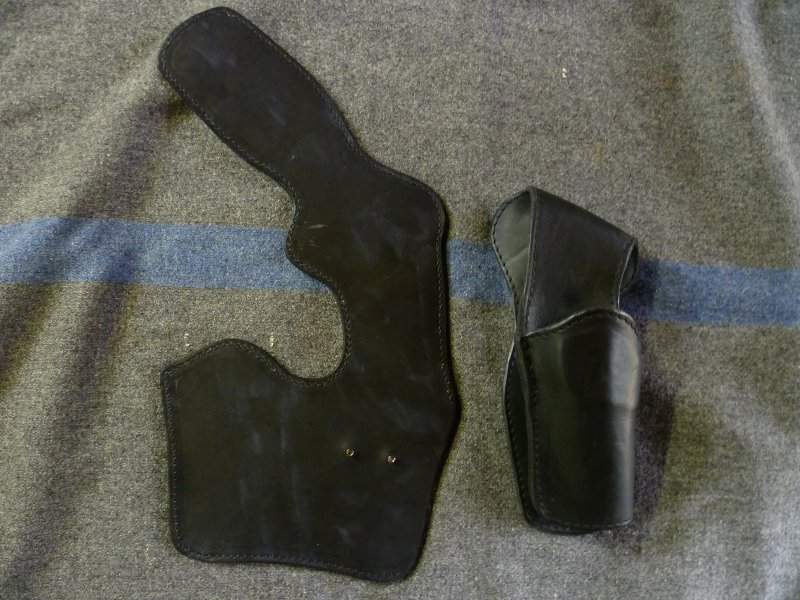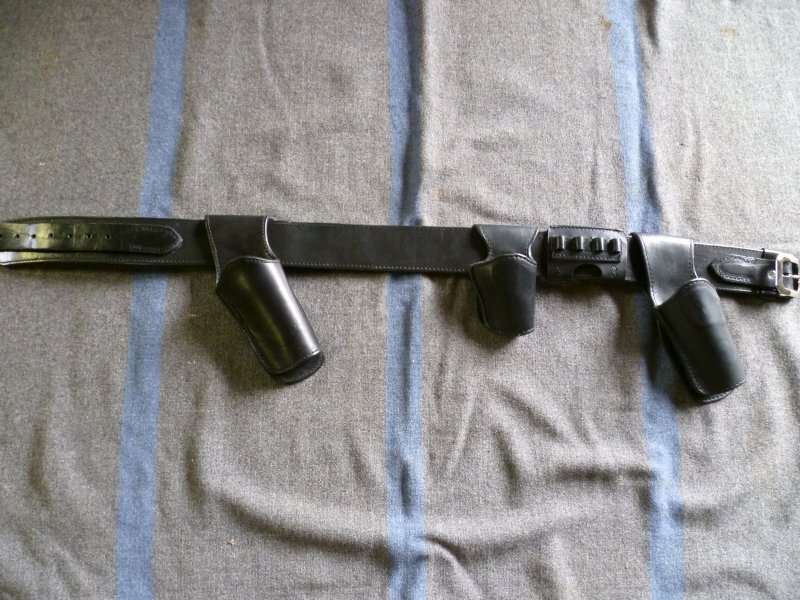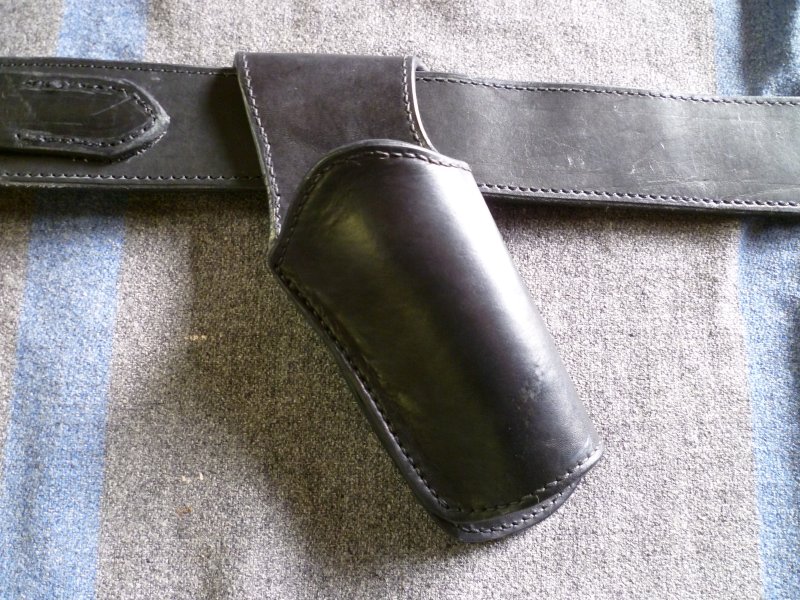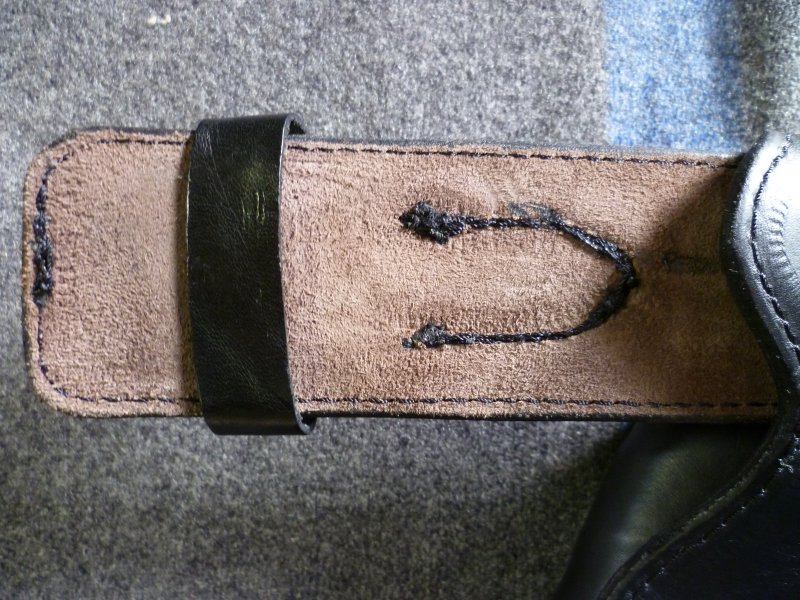-
Posts
4,804 -
Joined
-
Last visited
Content Type
Profiles
Forums
Events
Blogs
Gallery
Everything posted by dikman
-

Mexican loop question
dikman replied to dikman's topic in Gun Holsters, Rifle Slings and Knife Sheathes
I've resurrected this 'cos I'm still working on it!! In the intervening time I've bought a couple of Ruger Vaquero's, 5 1/2" barrels so I've decided to make Mexican loops for these. My pattern looks promising, but I've just realised that I've got about a 3" drop from the belt, which seems excessive for a loop style? I can shorten it a bit and still make it fairly easy to get the pouch through the loops. Question: should a Mexican Loop have minimal drop? I should add that I like having the holster hang a bit lower. Also, does this style work as a cross-draw? I don't think I've seen any photos used like this. -

Advice for cylinder arm machine for sewing saddlebags
dikman replied to sam000lee's topic in Leather Sewing Machines
Also, it sort of looks like the Adler equivalent of a Pfaff 335? If it is it may have a pretty short stitch length like my Pfaff. -

Advice for cylinder arm machine for sewing saddlebags
dikman replied to sam000lee's topic in Leather Sewing Machines
I see nothing in it's favour - too expensive, would need the binding fittings replaced with "standard", need a new servo, has small bobbin. Koreric probably has the best idea. -

Gluing layers for a gun belt
dikman replied to Hildebrand's topic in Gun Holsters, Rifle Slings and Knife Sheathes
I have a comb binder (for making booklets etc) and the front covers are A4 size thin acetate. If I don't want the layers of something to stick straight away I place pieces of this between the layers then gradually remove them as I work down the two pieces. I like the idea of making one piece overwidth, never thought of that (duh!). -
I had a 31K20 and that part was missing so I had to fabricate my own (copied from the parts pictures). Mine definitely didn't release the thread tension on the down-stroke and it worked fine. None of my machines do that.
-
Mizzy, probably would have been better if you handwheeled it, it's a bit to fast for me to figure out which way it's going (Brian's obviously got better eyes than me).
-

Anyone familiar with Singer 72W19 industrial?
dikman replied to Mizzy's topic in Leather Sewing Machines
Urk. That video was a bit hard to watch, glad it was short. -
Ouch! Is there any substantial stress at that point? If not JBWeld will certainly give a neat finish. Any chance of fitting a supporting bar (or two) underneath the area? They could be glued on to give a bit of support or drilled through and screwed on. Obviously welding would the be the ideal solution - if you know someone who can do it properly!
-
Can you post a photo of exactly what is broken? It will make it easier to advise on the type of repair needed.
-
Simple, really - if you're going to sew leather you can't beat fitting a servo.
-

Cowboy Action Leather Loading Strips
dikman replied to noobleather's topic in Gun Holsters, Rifle Slings and Knife Sheathes
(or maybe ). Not a problem when you wear suspenders - no belt loops. -
Or needle timing?
-
What do you mean by "too long"? Electronics are generally pretty reliable these days so leaving it on shouldn't normally be an issue. I left one of my servos on for over a day with no problems. Look for a fuse, most likely on the back of the control box, and check that, if that's ok try what Tom said and unplug it for a while. If it still doesn't work then it's most likely been damaged by a power surge or spike on the line. Sometimes, if you know what you're doing and you're very lucky, you can open up the control box and may see a damaged component that can be replaced - but these days you've got to be real lucky for that to work! From what I've found you can't buy the control box separately, only consolation is complete servos are relatively cheap.
-
That scenario would have caused me sleepless nights - I don't have the room for a collection of that size and yet the thought of them going to the dump........not good.
-
Good that you found the problem (operator error?) but I must admit I'm a bit confused by what you mean by a "simpler motor".
-
Looks good. I'm not surprised you had a problem with the claw blade. Now, this is just me, but on the Sig holster you have some right-angled stitch lines around the trigger area, I reckon it would look neater if you curved the stitch line. It wouldn't make it any stronger but aesthetically I think it would look better.
-
We don't get re-runs of the good old Westerns on tv here, it's mostly "reality" -type programmes (I call it garbage!!). Other than the news we don't watch a lot of commercial tv (funny that). I don't understand how the maker could think something like that was acceptable. I stitched a belt once (on a machine) and part way along I got the same thing, nothing for it but to remove all the stitches and start again.
-
I'm gobsmacked! I only knew about the 20 you mentioned you got recently, but another 10...... You'll have Constabulary drooling over his keyboard .
-
You have been a busy girl! A nicely grained piece of wood is always pleasing to look at. So, one down and 19 to go.......
-
I mentioned in another post that a chap asked me to basically duplicate his strongside holster as a crossdraw (he saw Gene Barry's holster in Bat Masterson and liked it). No big deal, although trying to copy an existing one is a bit of a pain, but I got pretty close. Two pieces, 8-9 oz. and 4-5 oz.all handstitched. I fitted a small spacer for the trigger guard, as per the original, but after it was finished realised it should have been thicker. Oh well, never done that before so didn't know how it would turn out. After gluing the pieces together I gave them a coat of Fiebing's black to put some colour in before working it.It came out patchy, which didn't matter as it was getting another coat, but interestingly when I wet it down to shape it the colour lost a lot of the patchy look. (Word of warning - if the gun being used to shape it has synthetic ivory handles wrap them up before messing with dye!! Fortunately the black marks cleaned off! Dumb!). The original holster has steel liners in it (which I don't use) and I eventually realised why - I reckon he used pre-dyed leather, which remains soft and won't hold a shape. The last photo is the back of the belt that he bought. Although the guy obviously had a decent sewing machine I thought the stitching left a lot to be desired.
-
So, it sounds like the whole tension assembly was moving slightly when that rod was pushed in?
-
Mizzy, could you have just replaced the pin inside the machine with a longer one? A nail, piece of fencing wire (old Australian joke, you can fix almost anything with fencing wire ) or a broken drill bit maybe? Just wondering.
-

any issues with putting a servo on a Singer 153W103?
dikman replied to ELeBlanc's topic in Leather Sewing Machines
3/4 hp should be fine. -
All of my used machines came with that type of feed dog, for what it's worth, and the replacement feet/feed dog assembly that I bought for my Pfaff 335 also had serrated teeth.
-
Koreric, that left photo could have the very faintest tinge of green in it - maybe. I've tried a few Feibing's "brown" dyes and all appeared to have faint reddish undertones so based on recommendations here I tried Walnut and at least that is BROWN. As for welts/fillers, I've never bothered with them as wet forming around the actual revolver gave me the fit I needed. Having said that, a chap has asked me to make a crossdraw holster that matches his existing pair, no real problem but they have a bloody thick welt in them! I'll probably fit a welt, but not quite as thick to make it easier for me.






